| Red oak | |
|---|---|
 | |
| Scientific classification | |
| Kingdom: | Plantae |
| Clade: | Tracheophytes |
| Clade: | Angiosperms |
| Clade: | Eudicots |
| Order: | Proteales |
| Family: | Proteaceae |
| Genus: | Carnarvonia |
| Species: | C. araliifolia |
| Binomial name | |
| Carnarvonia araliifolia | |
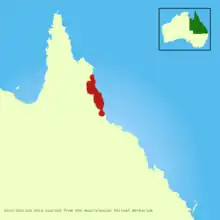 | |
Carnarvonia araliifolia, commonly known as the red oak, red silky oak, Caledonian oak or elephant's foot, is the sole species in the monotypic genus Carnarvonia, a member of the Proteaceae plant family. It is endemic to the rainforests of northeastern Queensland.
Description
The red oak is a large tree growing to 30 m (98 ft) or more in height, and it may have small rounded buttress roots. These may give the lower trunk the appearance of an elephant's foot, and are the source of one of the common names for the species.[5][6] The trunk bears numerous, closely spaced small lenticels.[7]
The large leaves are pedately compound and highly variable, having anything from 3 to 20 leaflets.[5][7][8] They range in size from 5 to 50 cm (2 to 20 in) long, including the petiole.[5][7][8] The leaves are arranged alternately on the branches.[5][8]
The inflorescence is a panicle, produced either terminally, in the leaf axils, directly from the branches, or on the trunk. They develop between November and May.[5]
The fruit is a woody follicle measuring up to 5 cm (2 in) long by 2.1 cm (0.8 in) wide, with the pedicel attached at one side.[5][7][8][9] They contain one or two winged seeds up to 45 mm (1.8 in) long overall.[5][8]
Taxonomy
This species was first described by the German-born Australian botanist Ferdinand von Mueller, from a specimen collected by John Dallachy in the forested mountains around Rockingham's Bay in Far North Queensland. He published the description in volume 6 of his massive work Fragmenta phytographiae Australiae in 1867.[3][7][10]
In 1995 the Australian botanist Bernard Hyland described a new variety of the species, C. a. var. montana, which was published in Flora of Australia volume 16. His description was based on a specimen he collected himself in 1972[9]
Phylogeny
The species has been placed in the subfamily Grevilleoideae because its cotyledons have auricles, which is unique to the subfamily.[11]
Etymology
The genus name Carnarvonia was given by Mueller to honour Henry Howard Molyneux Herbert, the Fourth Earl of Carnarvon.[5] The species epithet araliifolia is a combination of the genus Aralia and the Latin word folium, "leaf", and refers to the similarity of the leaves to those of some Aralia species.[5]
Distribution and habitat
The variety C. a. araliifolia is native to the coastal rainforests of north-eastern Queensland, from Cooktown south to Ingham, and from near sea level up to about 1,000 m (3,280 ft).[7][8] The other, C. a. monticola, has a smaller range from the Windsor Tablelands in the north to the southern edge of the Atherton Tablelands, and in altitudes from 650 to 1,200 m (2,130 to 3,940 ft). Both varieties grow in well developed rainforest[7][8][9]
Ecology
The fruits are eaten by Sulphur-crested cockatoos (Cacatua galerita) and cassowaries (Casuarius casuarius).[5][7]
Conservation
This species is listed by both the Queensland Department of Environment and Science and the IUCN as least concern.[1][2]
Uses
The timber of C. araliifolia has a rich red colour and is hard wearing. It has been used in house construction, especially for polished floors.[7]
Gallery
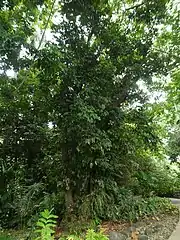 Growing in Cairns Botanic Gardens
Growing in Cairns Botanic Gardens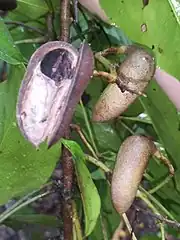 Fruit
Fruit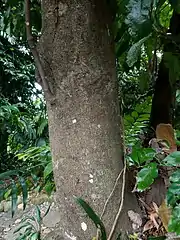 Trunk
Trunk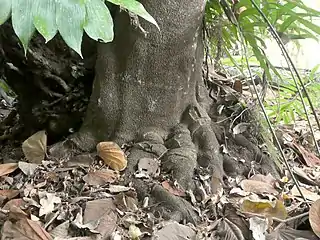 Small rounded butresses
Small rounded butresses Foliage
Foliage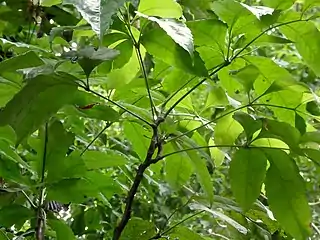 Foliage
Foliage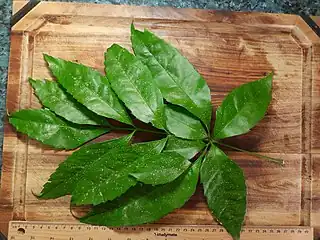 Coumpound leaf, upper side, with 13 leaflets
Coumpound leaf, upper side, with 13 leaflets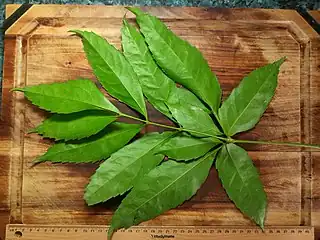 Under side of leaf
Under side of leaf
References
- 1 2 "Species profile—Carnarvonia araliifolia". Queensland Department of Environment and Science. Queensland Government. 2022. Retrieved 27 November 2022.
- 1 2 Forster, P., Ford, A., Griffith, S. & Benwell, A. (2020). "Carnarvonia araliifolia". IUCN Red List of Threatened Species. 2020: e.T112599708A113309115. doi:10.2305/IUCN.UK.2020-2.RLTS.T112599708A113309115.en. Retrieved 27 November 2022.
{{cite journal}}: CS1 maint: multiple names: authors list (link) - 1 2 "Carnarvonia araliifolia". Australian Plant Name Index (APNI). Centre for Plant Biodiversity Research, Australian Government. Retrieved 27 November 2022.
- ↑ "Carnarvonia araliifolia F.Muell.". Plants of the World Online. Royal Botanic Gardens, Kew. Retrieved 27 November 2022.
- 1 2 3 4 5 6 7 8 9 10 Cooper, Wendy; Cooper, William T. (June 2004). Fruits of the Australian Tropical Rainforest. Clifton Hill, Victoria, Australia: Nokomis Editions. pp. 408–9. ISBN 9780958174213.
- ↑ Wrigley, John; Fagg, Murray (1991). Banksias, Waratahs and Grevilleas. Sydney: Angus & Robertson. pp. 128–29. ISBN 0-207-17277-3.
- 1 2 3 4 5 6 7 8 9 F.A.Zich; B.P.M.Hyland; T.Whiffen; R.A.Kerrigan (2020). "Carnarvonia araliifolia var. araliifolia". Australian Tropical Rainforest Plants Edition 8 (RFK8). Centre for Australian National Biodiversity Research (CANBR), Australian Government. Retrieved 28 November 2022.
- 1 2 3 4 5 6 7 Hyland, B.P.M. (2020). "Carnarvonia araliifolia". Flora of Australia. Australian Biological Resources Study, Department of Climate Change, the Environment and Water: Canberra. Retrieved 28 November 2022.
- 1 2 3 F.A.Zich; B.P.M.Hyland; T.Whiffen; R.A.Kerrigan (2020). "Carnarvonia araliifolia var. montana". Australian Tropical Rainforest Plants Edition 8 (RFK8). Centre for Australian National Biodiversity Research (CANBR), Australian Government. Retrieved 28 November 2022.
- ↑ Mueller, Ferdinand von (December 1867). Fragmenta Phytographiae Australiae (Digitised archive copy, online, via biodiversitylibrary.org) (in Latin). Vol. 6. Auctoritate Gubern. Coloniæ Victoriæ, Ex Officina Joannis Ferres. p. 81. Retrieved 29 November 2013.
- ↑ Weston, Peter H.; Barker, Nigel P. (2006). "A new suprageneric classification of the Proteaceae, with an annotated checklist of genera". Telopea. 11 (3): 314–344. doi:10.7751/telopea20065733. Retrieved 28 November 2022.
External links
 Data related to Carnarvonia araliifolia at Wikispecies
Data related to Carnarvonia araliifolia at Wikispecies Media related to Carnarvonia araliifolia at Wikimedia Commons
Media related to Carnarvonia araliifolia at Wikimedia Commons- View a map of historical sightings of this species at the Australasian Virtual Herbarium
- View observations of this species on iNaturalist
- View images of this species on Flickriver
